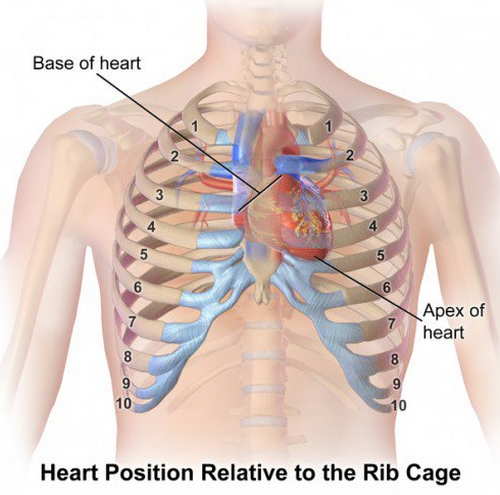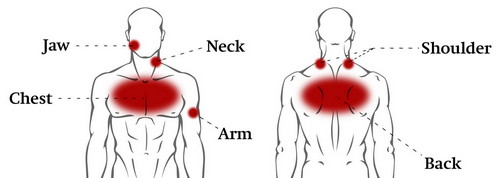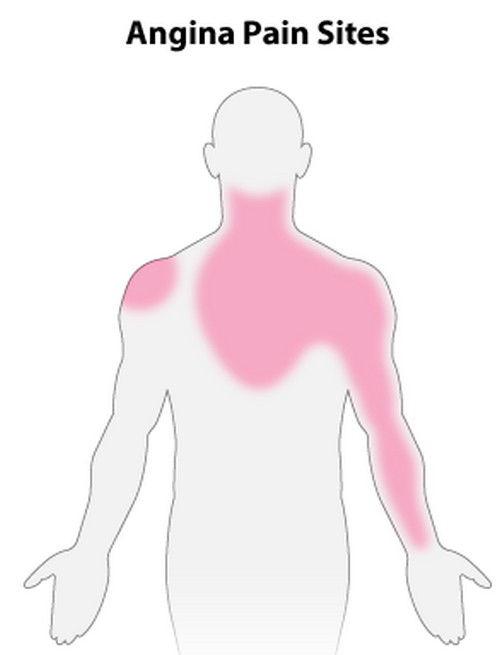Where is your Heart Located and What causes Chest Pain
Typically, any pain arising from chest sets up an alarming situation for people for its possible causes. Most of the people consider any pain in the chest like a heart attack. Surprisingly, many people are not even sure about the exact location of the heart. It is a prime reason why the majority of people consider all chest pains as heart pain.
It is necessary to understand the basic structure and position of the heart to recognize different types of chest pains. Not all kinds of chest pains are related to the heart. Millions of people complaint a chest pain is taken to hospital emergency, but not even one-third of them are diagnosed with the heart attack or unstable angina, which is a warning sign of heart attack.
One tricky problem with heart problems is that people experience them in different ways. The only common symptom among all patients of a heart attack is “chest pain.” It is the most significant reason we often misunderstand chest pain as a heart attack.
Among other reasons of chest pain, there could be many possibilities. It could be a physical reason, psychological reason or a combination of both. Most of these cases are not lethal, but confusion causes stress and uncertainty, which makes the condition worse.
Where is my heart located?
The location of the heart is accurately towards the left side of the midline, of the body. The precise position of your heart is between the left and right lung (1). The breastbone (sternum) covers it, and the heart resides slightly inclined left. (2)

Image 1: Position of heart inside the rib cage : Heart Location
Picture Source: usercontent2.hubstatic.com
It is protected by a membrane, which is called pericardium (3). The heart is surrounded by blood vessels and arteries, which govern the flow of blood into and out of your heart.
The size of your heart is close to your fist, when you, close it. If you happen to place your hand on your chest, you may confuse yourself on the exact location of the heart, as the lub dub sound of heart doesn’t hint an accurate position.
However, if you put your hand in the center of the chest, move your hand only a little towards left, and you will feel your heartbeat. Do they not confuse the heart to be located aside or over other organs.
The spine is right behind the heart, and rib cage protects the heart being outer to it. Together, the human body is a complex system of perfectly aligned organs, playing protective roles for each other.

Photo 2: The exact location of heart in human body
Picture Source: i.pinimg.com
Why does my chest hurt?
Sometimes a sudden pressure or pain with an uncertain origin may look like heart pain. All the pains, which feel on the chest but do not originate, from the heart, do not heart pains. Sometimes even pain in the exact location of a heart is also not a heart attack.
On the other side, the symptoms of a heart attack may or may not necessarily be in the position of the heart. Heart attack symptoms show up differently in different people. It suggests that using the location of the heart is not an ideal standard to determine a chest pain as the heart attack (4) .

Image 3: A representation of chest pain
Picture Source: s3.amazonaws.com
There are so many types of patterns that appear in chest pain. Usually, the chest pain can start anywhere from your neck to upper abdomen. Irrespective of the cause, the chest pain can be of following types (5).
- Sharp and intense
- Mild and irregular
- Burning sensation
- Stabbing like pain
- Pressure like pain
- A tight and crushing feeling
Now it is clear that location cannot be the best way to estimate the type of pain. The next question to strike the mind is how to know if the chest pain is a heart pain or not? To answer this, the following is necessary information, signs, and symptoms of most common chest pains.

Photo 4: Network of chest pain in human body
Picture Source: thedoctorsofprairie.com
Chest pains that represent a heart condition
Following are the most common types of heart problems, which describe themselves as chest pain.
Heart attack
The most obvious and no doubt the most dangerous of all types of chest pains is a heart attack. A heart attack is a chest pain, which feels like a tightening and squeezing feeling directing towards the heart. It can prolong for seconds or minutes, deciding the fate of the body. In severe heart attacks, there are fewer survival chances.
The primary symptoms, which characterize a heart attack, are as follows.
- A sharp shooting pain (6)
- Heartburn like feeling
- Radiating pain which spreads to other body parts
- Sweating and shortening of breath
- Nausea and stress
A heart attack is a severe medical condition. In case of these heart attack symptoms, rush to the medical emergency as soon as possible.
Coronary artery disease
Coronary artery disease is a reason behind a type of chest pain that relates to the heart. It is a dysfunction of coronary blood artery, which is otherwise responsible for supplying oxygen and blood to the heart. It is not a one-time problem but takes several years to develop it. Coronary artery disease also feels like chest pain. It is related to heart and can cause a heart attack. The signs that show up in coronary artery disease are as follows.
- Shortness of breath
- Radiating pain
- Causes heart attack
Many factors contribute to developing coronary artery disease. They include high cholesterol, alcohol consumption, excessive smoking, lifestyle changes and diabetes (7).
Angina
Angina is sometimes considered as the heart attack. It is similar to a heart attack but has less severe nature. Angina also represents its symptoms as chest pain. Angina pain is caused by low blood pressure, which causes core muscles to tighten up. Other symptoms include;
- Radiating pain
- Dizzy feeling
- Nausea
- Stress
- Sweating
Rush to the nearest hospital emergency if you suspect your chest pain to be angina.

Photo 5: Possible areas of radiating Angina pain
Picture Source: www.riverpharmacy.ca
Myocarditis
Myocarditis also shows up like chest pain. It is a condition, which symbolizes the swelling of the myocardium. The myocardium is the outer muscle of the heart that protects it. Myocarditis is usually a viral infection (8). The typical signs to look for categorizing the chest pain as myocarditis are as following.
- Stabbing like pain
- Pain radiating to nearby organs
- Fever like feeling
- Dizzy feeling
- Stomach pain and diarrhea
- Stress and fatigue
- Irregular heartbeat

Image 6: Myocarditis: inflammation of outer heart muscles
Picture Source: www.secondscount.org
Pericarditis
Like Myocarditis, Pericarditis is also a heart-related condition that denotes itself in the form of chest pain. Pericarditis is the infection of the pericardium, which is the outer, layer which surrounding heart. It is not as such a disease itself but a result of a preliminary infection (9).
This initial condition could be cancer, heart attack, trauma, autoimmune disease or anything. Common symptoms include radiating, mild to moderate type of chest pain, which comes with an irregular heartbeat.
Chest pains that do not represent a heart condition
Now that we are clear on different types of chest pains, related or not related to heart, it is necessary to know basics about both. Following are non-cardiac conditions that cause chest pain.
Pleuritis
Pleuritis is also called pleurisy, which is an inflammation of the inner lining of lungs and chest. It feels like a sharp pain, which becomes intense during a cough, sneeze or fast breathing (10). Bacteria or virus causes it. Sometimes it is a secondary infection caused by rheumatoid arthritis, lupus or cancer.
Pneumonia
Pneumonia is a type of lung infection that may cause chest pain. This type of chest pain feels like pressure and often comes up with fever, chills, cold and cough.
Pulmonary embolism
Pulmonary embolism is a health condition when a blood clots males it way to lungs and cause acute pleuritis. It shows up as troubled breathing and an increase in heartbeat (11). It also causes fever, stress, and fatigue.
Pneumothorax
Pneumothorax is caused by an injury to the chest that results in lung collapses. It releases air into the chest cavity, which feels like chest pain. It becomes worse when you breathe, sneeze or cough.
Pulmonary hypertension
The pain caused by pulmonary hypertension and asthma resembles angina. However, it is caused by high blood pressure in lungs.
Gastroesophageal reflux disease/ acid reflux
Acid reflux occurs when the body throws stomach contents back to the throat. It shows up as a burning sensation in the chest, which is common in many heart-related chest pains too. Many factors may induce acid reflux such as obesity, pregnancy, eating spicy foods, etc (12).
Peptic ulcers
Painful sores on stomach lining or the first part of the small intestine can also cause chest pain. It is common for people with excessive alcohol or smoking habits. This type of chest pain is mild and gets better with antacids.
A hiatal hernia
The chest pain caused by a Hiatal hernia exemplifies itself as reflux symptoms. The chest pain of a Hiatal hernia feels like heartburn, but it gets better when you lie down and rest (13).
Gallbladder problems
Sometimes a particular type of chest pain appears on the right lower chest area or upper abdomen. This kind of chest pain is caused by a gallbladder problem and has no link with heart (14).
Pancreatitis
Pancreatitis is another condition, which may cause pain in the lower chest. It gets worse when you lay down and becomes better when you lean forward.
Difference between symptoms of cardiac and non-cardiac chest pains
Chest pain with relevance to heart
- Chest pains caused by a heart condition usually start in the morning.
- Cardiac pains feel like compression or squeezing sensation.
- They also show up like burning or sharp pain.
- Cardiac pains radiate to other parts of the body, i.e., arms, shoulder, neck, etc.
- Cardiac-related chest pains affect the movement of upper body parts like shoulders and arms.
- These pains may become intense after a heavy meal.
It is recommended to seek emergency medical aid as soon as possible in case of such pains.
A chest pain, which is irrelevant to heart
- Non-cardiac chest pains may show up in evening or night most of the times; they rarely show up early morning.
- These pains don’t have a definite origin.
- These pains are not radiating.
- These pains appear to be like heartburn.
- They may come and go in minutes, unlike cardiac pain.
- Physical contact may increase it.
The Final Word
Pain may not seem like a real problem and is often ignored. Pain is not a disease itself, but it is an indication by the body that something is not happening right. In case of chest pain, it represents a dysfunction or infection of an organ located within the chest. The pain of chest should no be ignored because all the vital organs are located chest including heart, lungs, stomach, and liver.
Most of the chest pains that commonly hit people are not related to the heart. Only a lesser number of these chest pains are actually due to the heart. If the chest pain is continuous that lasts for days; it should be taken seriously. Also, the chest pain is dangerous if you are in middle or older ages.
References:
- https://socratic.org/questions/in-what-anatomical-position-of-the-body-is-the-heart-located
- http://www.innerbody.com/image/card01.html
- http://teachmeanatomy.info/thorax/organs/heart/pericardium/
- https://www.mayoclinic.org/diseases-conditions/heart-attack/symptoms-causes/syc-20373106
- https://www.webmd.com/pain-management/guide/whats-causing-my-chest-pain#1
- https://svhhearthealth.com.au/wps/wcm/connect/4a4ddd75-45a8-4de1-9c65-11c3a8dd9ec2/Causes+of+chest+pain.pdf?MOD=AJPERES
- https://www.nhlbi.nih.gov/health-topics/coronary-heart-disease-risk-factors
- https://www.myocarditisfoundation.org/about-myocarditis/
- https://www.ncbi.nlm.nih.gov/pmc/articles/PMC2878263/
- https://www.nhsinform.scot/illnesses-and-conditions/lungs-and-airways/pleurisy
- Emedicine.medscape.com/article/300901-overview
- https://my.clevelandclinic.org/health/diseases/15851-gerd-non-cardiac-chest-pain
- https://www.webmd.com/digestive-disorders/hiatal-hernia
- https://www.medicinenet.com/gallbladder_pain_gall_bladder_pain/article.htm
